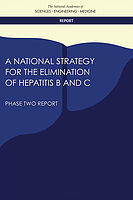A National Strategy for the Elimination of Hepatitis B and C - PHASE 2

March 28, 2017
FOR IMMEDIATE RELEASE
U.S. Could Be Rid of Hepatitis B and C as Public Health Problems, Preventing Nearly 90,000 Deaths by 2030, With Better Attention to Prevention, Screening, Treatment, and Creative Financing for Medicines.
WASHINGTON – Hepatitis B and C kill more than 20,000 people every year in the United States. A new report from the National Academies of Sciences, Engineering, and Medicine presents a strategy to eliminate these diseases as serious public health problems and prevent nearly 90,000 deaths by 2030.
“Viral hepatitis is simply not a sufficient priority in the United States,” said Brian Strom, chair of the committee that carried out the study and chancellor and university professor, Rutgers Biomedical and Sciences, Rutgers University, Newark, N.J. “Despite being the seventh leading cause of death in the world – and killing more people every year than HIV, road traffic accidents, or diabetes – viral hepatitis accounts for less than 1 percent of the National Institutes of Health research budget.”
About 1.3 million people in the United States have chronic hepatitis B, and about 2.7 million have chronic hepatitis C. These infections also increase risk of liver cancer. Together, hepatitis B and C cause about 80 percent of the cases worldwide of liver cancer, which has been steadily increasing in both new cases and deaths in the United States since the early 2000s. The incidence of liver cancer in the United States increased 38 percent between 2003 and 2012, and liver cancer deaths increased 56 percent in the same time, primarily due to viral hepatitis.
The world has the tools to prevent these deaths. Hepatitis B is preventable with vaccination, and recent advances in treatment make hepatitis C curable with short and easily tolerable courses of medicines. The committee said the number of deaths from hepatitis B could be cut in half by 2030 by diagnosing 90 percent of the nation’s chronic hepatitis B patients, bringing 90 percent of those to care, and treating 80 percent of those for whom treatment is warranted. These actions would avert more than 60,000 deaths and also reduce liver cancer and cirrhosis from hepatitis B infection by about 45 percent. Similarly, treating everyone with chronic hepatitis C would reduce new infections by 90 percent by 2030 and reduce hepatitis C deaths by 65 percent over the same time. These actions would avert 28,800 deaths by 2030 and depend on diagnosing 110,000 new cases a year between now and 2020, gradually dropping off to 70,000 a year by 2025. » Continue Reading on Website
